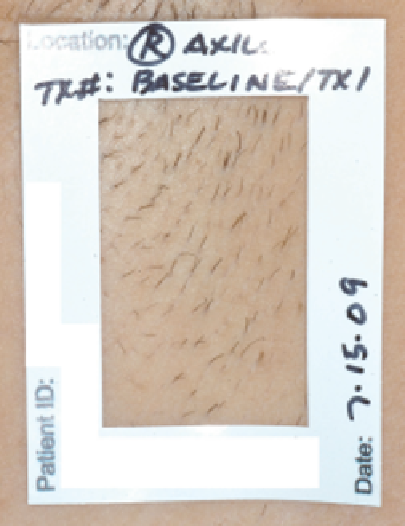Biomedical Engineering Reference
In-Depth Information
(
A
)
(
B
)
Figure 5.2
Visual decrease in hair thickness and color in a study subject. (
A
) baseline and (
B
) 15-month follow-up visit. This subject had a 60% decrease in hair
thickness and a 40% decrease in hair color (44).
the target chromophore. Importantly, every patient should
always be evaluated for the presence of a tan, and if present,
laser treatment should be delayed or the treatment parameters
appropriately adjusted until the tan has faded. Finally, the
patient's hair color should be noted as the chromophore for
LHR is melanin. Black and brown hairs contain suffi cient
amounts of melanin to serve as a chromophore for LHR.
In contrast the lack of melanin, paucity of melanin or presence
of eumelanin in the hair follicle, which clinically correlates to
white, gray, or red/blonde hair is predictive of a poor response
to LHR. For patients with little to no melanin in their hair fol-
licles, attempts have been made to use an exogenous chromo-
phore that can be topically delivered to the hair follicles,
thereby making the removal of white, gray, red, and blonde
hair hypothetically possible. This concept was fi rst demon-
strated with a topical carbon solution dissolved in mineral oil
(20). However, we have noticed very little effi cacy of topical
chromophores in our vast experience.
maintenance therapy and should be advised of this possibility.
Procedural pain is expected with LHR but can be mini-
mized with topical anesthetics and the use of cold air cooling.
Erythema and edema are also expected with treatment and
may last up to 1 week. Patients should be aware of the need for
strict sun avoidance for a minimum of 6 weeks before and
after each treatment.
Preoperative Preparation and Laser Safety
The need for topical anesthesia is variable among patients
and particular anatomic sites. Various topical anesthetics,
including lidocaine, lidocaine/prilocaine, and other amide/
ester anesthetic combinations, can be used to diminish the
procedural discomfort, and should be applied 30 minutes to
1 hour before treatment under occlusion. Care should be taken
when using lidocaine or prilocaine to apply these medications
to a limited area to diminish the risk of lidocaine toxicity or
methemoglobulinemia, respectively.
Patients should be placed in a room with a treatment chair
that makes the desired treatment area easily accessible. The
room should be adequately cooled to keep the laser device
from overheating and be free of any hanging mirrors or uncov-
ered windows. A fi re extinguisher should be readily available,
especially if oxygen is being used. Having a vacuum device on
hand during treatment can minimize the plume and unpleas-
ant odor created by each laser pulse. Because the retina con-
tains melanin which can be damaged by all LHR devices,
proper eye protection is absolutely critical for both the patient
and the laser surgeon. Each device requires the use of protec-
tive goggles that are unique to the device's particular wave-
lengths. Goggles cannot be interchangeably used with laser or
IPL devices of other wavelengths. Furthermore, because of the
risk of retinal damage, it is the authors' strong opinion that
one should never treat a patient for LHR within the bony orbit.
Informed Consent
An explanation of the potential risks of LHR should be
reviewed as part of the informed consent process. The risks
include but are not limited to temporary and permanent
hypo/hyperpigmentation, blister formation, scar formation,
ulceration, hive-like response, bruising, infection, acne fl are,
and folliculitis. For those patients with Fitzpatrick skin type IV
or greater or of Mediterranean, Middle Eastern, Asian, or
South Asian descent, the low risk of paradoxical hypertrichosis
(conversion of vellus hairs to terminal hairs), especially when
treating the lateral face and jaw, should be reviewed (21-24).
Patients should be counseled that permanent and complete
hair removal is not likely, but that with multiple treatments,
signifi cant long-term reduction can be achieved. Hirsute
women with hormonal abnormalities may require continued

















